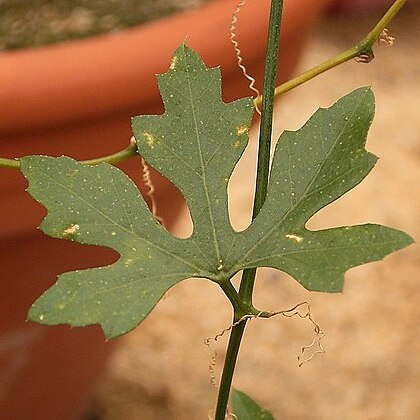Foetid perennial with thick tuberous roots and long slender climbing or more rarely prostrate stems, varying from nearly glabrous to more or less densely and shortly pubescent. Stems slender, longitudinally sulcate, usually much branched and usually thinly hairy when young, glabrescent. Leaves fleshy drying subcoriaceous rarely thinner in texture, in outline cordate-reniform or suborbicular-cordate, usually distinctly angular sometimes somewhat lobed, rarely as far as the middle, deep green when alive but usually drying greyish green (often paler and more greyish on lower surface) 2-7 cm long and broad with a shallow rounded to subtruncate, occasionally broadly triangular basal sinus, an obtuse or rounded rarely acute, sometimes mucronate apex and lobes and a subentire to crenulate or somewhat crenate-dentate margin; petioles 1-4 cm long, usually rather slender. Male plants: flowers racemose; common peduncle slender to filiform, up to about 20-flowered, almost invariably shortly and sparingly pubescent, 2-10 cm long; pedicels erect-patent, filiform to capillary, 3-16 mm long, often with minute bracts at the base; receptacle narrowly campanulate to subcylindric 2-4 mm long, 1-3 mm wide, usually more or less hairy; sepals narrowly triangular, erect, 1-2 mm long; petals light yellow, ovate-oblong or ovate-triangular, subacute, densely papillose-puberulous on the outside, 4-9 mm long. Female plants: flowers solitary, on a filiform peduncle up to 8 mm long in fruit; ovary oblong-fusiform, more or less beaked, sometimes distinctly but finely longitudinally striate. Fruit ovoid, conical-acute to rostrate, orange to red, smooth and glabrous when ripe, few-seeded, 1.5-2 cm long, about 8 mm in diam. Seeds smooth, 6-7 mm long, 3-4 mm broad and 2-3 mm thick.
More
A pumpkin family herb. It has a tuber. It is a climber with tendrils that curl. The stems are angled. It grows 2.5 m long. The leaf shape varies. Leaves are heart shaped and have lobes. The flowers are pale yellow. Male flowers are in groups and female flowers occur singly. The fruit is oval and tapers to the tip. They are orange yellow when ripe.
Like K. capensis but dioecious and leaves sometimes scarcely lobed.

